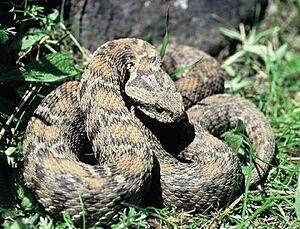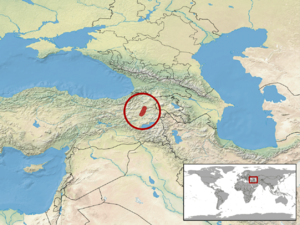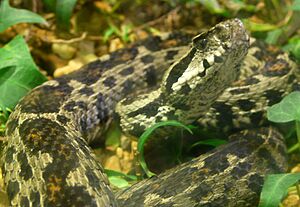Wagner's viper facts for kids
Quick facts for kids Wagner's viper |
|
|---|---|
 |
|
| Conservation status | |
| Scientific classification | |
| Genus: |
Montivipera
|
| Species: |
wagneri
|
 |
|
| Synonyms | |
|
|
Wagner's viper (Montivipera wagneri) is a special type of venomous snake. It is also known as the ocellate mountain viper. These snakes belong to the Viperidae family. They live in the mountains of eastern Turkey and northwestern Iran. There are no different types (subspecies) of this snake known.
Contents
Where Did Its Name Come From?
The name wagneri honors Moritz Wagner. He was a German explorer. Moritz Wagner collected the first known sample of this snake in 1846.
What Does Wagner's Viper Look Like?
Wagner's viper can grow to be about 70 to 95 centimeters (27 to 37 inches) long. This measurement includes its tail.
Its head is quite large and separate from its neck. The front of its nose is rounded. Small, ridged scales cover its head. The eyes are large and surrounded by 12 to 15 scales. There are usually 9 scales above its mouth and 12 to 13 below.
Around the middle of its body, it has 23 rows of ridged scales. It also has 161 to 170 belly scales. The scales under its tail are paired, numbering 23 to 31.
The snake's main color is grayish. It has a pattern of spots or blotches down its back. These spots are light brown, yellowish-brown, or orange. They have black edges. Each spot is about 4 to 8.5 scales wide.
The top of its head often has two long black marks. These marks look like a large, dark "V" shape. This "V" does not meet at the top. It stretches back towards the snake's neck. There is also a dark stripe from its eye to the corner of its mouth.
Where Does Wagner's Viper Live?
Montivipera wagneri is found in the mountains. It lives in eastern Turkey and the nearby northwestern part of Iran. The first snake of this type was found near Lake Urmia in Iran.
How Is Wagner's Viper Protected?
This snake is in serious trouble. In 1996, it was listed as "endangered." By 2009, its status changed to "critically endangered." This means it is very close to disappearing forever.
Its numbers have dropped a lot. People catch these snakes to sell them as pets around the world. Also, a new dam project, the Karakurt dam, will destroy over 80% of their natural home.
Wagner's viper is also listed under CITES Appendix II. This means that international trade of this snake is watched very closely. It is also a strictly protected animal under the Berne Convention.
Zoos are helping to save these snakes. For example, nine Wagner's vipers hatched at the St. Louis Zoo in 2013. The zoo is part of a special program. This program helps breed and protect endangered animals like the Wagner's viper.
What Kind of Habitat Does It Like?
Montivipera wagneri lives in rocky and grassy areas. It is found at high places, from about 1600 to 1900 meters (5250 to 6230 feet) above sea level.
Life Cycle and Reproduction
M. wagneri is a viviparous snake. This means the mother snake gives birth to live young. The babies hatch inside her body, not from eggs laid outside.



